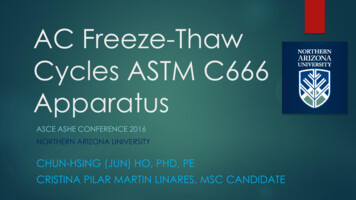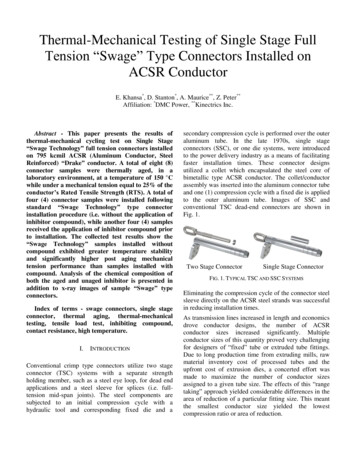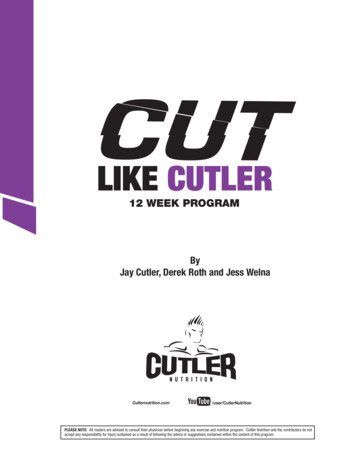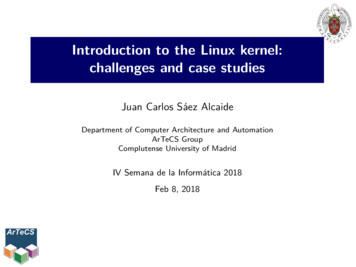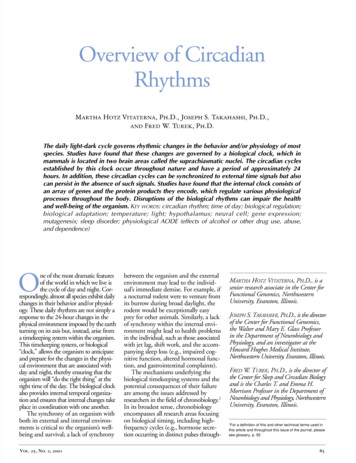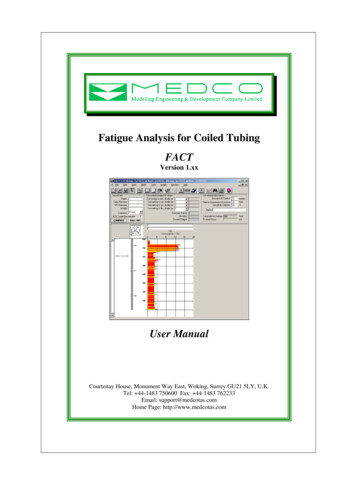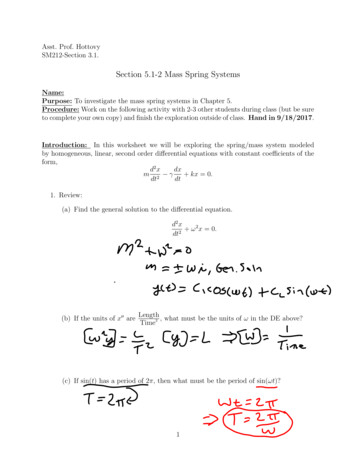
Transcription
Systems Engineering and Project Management (SEPM)Joint Working GroupGuide to Life Cycles and Life Cycle ModelsIssue 1.1Mar 2017SummaryThe Joint Working Group (JWG) on Systems Engineering / Project Management Integration was formed byINCOSE UK and APM in 2013 as a result of a recognition by both organisations that closer integration of thetwo disciplines should increase the probability of project success. The aim of the JWG is to develop andpromote good practice and guidance dovetailing SE and PM, and promote systems thinking across the widerdecision making community in the UK.As part of the work towards this aim, the JWG has been exploring aspects of SE and PM life cycles andprocesses. This document reviews various life cycle representations within the PM and SE disciplines,identifies where these representations overlap and are complementary, and explores area for potentialconfusion or mis-understanding between the disciplines.The information within this document does not represent an exhaustive list, but provides a gateway todifferent life cycle representations and how they support decision making. This document is intended to beread in conjunction with its accompanying JWG documents, Guide to SE/PM Processes and Integration of LifeCycle Representations.In order to aid comprehension, a categorisation of the range of life cycles is proposed, grouping them intoScenarios (strategic life cycles), Approaches (flows and interactions) and Models (methodology frameworks).These are not exhaustive or exclusive categories, but they help to describe the different nature of life cyclerepresentations, particularly across the PM and SE disciplines and communities.The role of the life cycle is explored, particularly as a governance and decision framework, and how this alignsthe PM and SE disciplines and the management and development life cycles. Guidance is provided on life cycleselection, explaining the factors to be taken into account when considering which life cycle model to use.AuthorsAndrew Gray, Ken Richardson, Kate Rooke, Tony Thornburn 2016 A. Gray, K. Richardson, K. Rooke & T. Thornburn. Published and used by INCOSE UK Ltd., INCOSE andthe Association for Project Management with permission.The following document represents the thoughts and conclusions of the Systems Thinking SIG and not necessarily the views of theAPM or INCOSE UK. It is intended to assist Project, Programme and Portfolio Management and Systems Engineering practitionerswishing to explore concepts and ideas around Systems Thinking in P3M and to stimulate discussion on the subject. Feedback on thecontents of this paper should be sent to the Systems Thinking SIG (SystemsThinkingSIG@apm.org.uk). It therefore does notconstitute any formal position (or liability arising) on the part of the International Council for Systems Engineering (INCOSE), INCOSEUK Ltd. or the Association for Project Management (APM), nor should any formal endorsement by these bodies be inferred.
Contents1.2.3.4.5.6.7.8.9.10.Introduction4Purpose and ScopeDocument StructureTerminologyKey referencesAcknowledgements45666APM and INCOSE life cycle definitions7Definition of a life cycleSystem engineering life cyclesProject, programme and portfolio life cyclesOther generic life cycle depictions78910Categorising life cycle scenarios, approaches and models11Addressing a multitude of representations11Life cycle scenario category13Scenario typesExamples of new product/facility design development and introductionExamples of transformational changeExamples of capability or service acquisition13131416Life cycle approach category18Life cycle ApproachesUsing linear representations to illustrate the differencesBase approachExperimental approachIncremental approachEvolutionary approach181818191919Life cycle model category21Management models and development modelsExamples of P3M life cycle modelsExamples of sequential system development life cycle modelsExamples of iterative and dynamic system development life cycle models21212426Category relationships and product life spans29Project life cycles and product life spans29Governance and feedback mechanisms31The life cycle as a governance and decision frameworkProgramme tranches and project stagesUse of stage gates313233Comparisons of SE and P3M definitions34SE and P3M perspectivesSystem-of-interest life cycle vs a project/programme life cycleCommonality of descriptionsUse of Vee Model to depict programme management strategy34343535Life cycle selection and tailoring37Align scenarios with strategic directionSelecting the life cycle approachThe influence of riskFollow, but monitorCombine, but do not confuse3737394041Guide to Lifecycle Models: Issue 1.1Page 2
FiguresFigure 1:Figure 2:Figure 3:Figure 4:Figure 5:Figure 6:Figure 7:Figure 8:Figure 9:Figure 10:Figure 11:Figure 12:Figure 13:Figure 14:Figure 15:Figure 16:Figure 17:Figure 18:Figure 19:Figure 20:Figure 21:Figure 22:Figure 23:Figure 24:Figure 25:Figure 26:Figure 27:Figure 28:Figure 29:Figure 30:Figure 31:Figure 32:Generic Life Cycle Representation (Adcock & Farncombe)Linear Project Lifecycle (from APMBOK)Linear programme lifecycle (from APMBOK)Rational unified process life cycleThere are many different life cycle representationsA New Product Design Development and Introduction framework ( Cummins Turbo Technologies)Panoptic Software Development Process ( Panoptic Development Inc)RIBA Plan of Work 2013 ( Royal Institute of British Architects)Transition from Current to Future StateNHS Change Model ( NHS)UK MoD CADMID & CADMIT Acquisition Life CyclesUS DoD Acquisition Life CycleExample linear life cycle used to illustrate Base ApproachAn example of an Experimental ApproachAn example of an Incremental ApproachAn example of an Evolutionary ApproachSimplified representation of PRINCE2 project management life cycle process modelISO21500:2012 model of project phasesA representation of the Managing Successful Programmes life cycle modelPortfolio definition and delivery cycles (after Management of Portfolios )Portfolio life cycle definition (after APMBOK)Example Waterfall ModelsExample extended Vee Model (after US DoT Federal Highway Administration)Boehm’s Spiral Development ModelA representation of an agile development life cycle model (after Ambler & Lines)Comparison of corporate business, facility/product and project life spans (Wideman 1987)Hypothetical example illustrating life cycle categories and product life-spanExample use of Stage Gates within life cycle Phases at AirbusExample use of Stage Gates within the life cycle ( Cummins Turbo Technologies)SE and P3M – different perspectives on changeProgramme Management as a Vee Model (encompassing SE elements)Obeng’s descriptions of project 72829303233343538Workstreams within the APM/INCOSE Joint Working GroupGeneric Systems Engineering Life Cycle Stages (from SEHBK)Life cycle approach selection table (adapted from Adcock & Farncombe 2009)An example of development model selection based on consideration of risk483940TablesTable 1:Table 2:Table 3:Table 4:Guide to Lifecycle Models: Issue 1.1Page 3
1.IntroductionPurpose and ScopeIn 2013 the UK chapter of the international council on systems engineering (INCOSE UK) and the associationof project management (APM) founded a joint working group to realise this potential of collaborative workingbetween project management (PM)1 and systems engineering (SE)2. This Joint Working Group was arrangedinto several Workstreams as shown in Table 1, of which Workstream 8 was set up to look at the processes andlife cycles involved across the two disciplines.Table 1:Workstreams within the APM/INCOSE Joint Working Group3What are the benefits?WS 1Compelling value propositionHow to deliver the benefits?WS 8Processes and lifecyclesWS 4Roles and responsibilitiesWS 6Competency frameworkWS 7Education and trainingHow to promote the benefits?WS 2CommunicationWS 3Guidance materialWS 5Case studiesThere are 3 main Objectives of Workstream 8 “Processes and Life Cycles”:41. To identify where SE and PM models, approaches and ways of working overlap and arecomplementary, and identify the nature of the relationships between the two disciplines.2. To develop (where appropriate) a set of unified processes and lifecycle models (or look to utiliseexisting unified models and processes) .1 The term ‘project management’ in this context encompasses all aspects of project, programme and portfolio management (P3M)2 SE is an interdisciplinary approach and means to enable the realization of successful systems. Successful systems must satisfy theneeds of its customers, users and other stakeholders (SEBoK v 1.7 BKCASE October 28,2016)3For further details on the APM/INCOSE JWG on SE/PM Integration, see JWG document “Aims and Objectives”, Version 14See APM/INCOSE JWG on SE/PM Integration, “Workstream 8 Project Brief”, Version 1, September 2013Guide to Lifecycle Models: Issue 1.1Page 4
3. To communicate, review and exploit these processes and lifecycle models amongst the PM and SEcommunities.This document addresses Objectives 1 and 3 from a life cycle perspective. When looking at life cycles it isworth noting that we are considering any change situation, including the introduction or modification ofproducts or capabilities. The purpose of this document is to form a framework around which key messagesand information can be captured related to the subject of life cycles within the PM and SE environments. Thistherefore also means that information can be provided in support of the other Workstreams.It is not intended as an exhaustive guide to the range of life cycle representations that are used.A life cycle should be chosen based on what works for the undertaking in question, and therefore selectingand tailoring a life cycle is a key function. This guide aims to equip the reader with a better understanding ofthe options available in order to support this decision and address the complexity often associated withprojects that require both a strong SE and PM function.This guide is not intended to compare and review individual processes within the life cycles. This will beundertaken in an accompanying publication “Guide to SE and P3M Processes”. Developments in integratinglife cycle representations identified in this document can be found in the third document in this series “Integrated Life Cycle Representations” (and which therefore specifically addresses Workstream Objective 2).Document StructureThis document explores the relationships between lifecycle representations in P3M and Systems Engineeringthrough 10 chapters. In addition to this introduction, these chapters cover:What is a life cycle?What sort of life cyclesare there?What is a life cyclescenario?What is a life cycleapproach?What is a life cyclemodel?How do scenarios,approaches and modelsinteract?How do life cycles helpprovide control?What differences arethere between SE andPM perspectives?How do we select themost appropriate lifecycle representation?APM and INCOSE life cycle definitions. A comparison of various definitions of a life cycleand whether any conflicts arise from differences in definitions.Categorising life cycle scenarios, approaches and models. Describes a means ofcategorisation of the wide range of different life cycle representations, and introduces theScenario, Approach and Model categories.Life cycle scenario category. A review of certain P3M process frameworks, covering thosewithin the APM Body of Knowledge, the PMI Body of Knowledge, ISO standards and theGlobal Best Practice Suite from Axelos.Life cycle approach category. Identification of the overlap of processes included within SEand P3M frameworks, using the ISO standards for a back-to-back comparison.Life cycle model category. Identification of key areas where SE and P3M processes cancombine or interact to provide an enhanced performance or output.Category relationships and product life spans. A review of how the scenarios, approachesand models combine, and how where overlaps and frictions can arise between SE and P3Mprocesses, including the relationship between the product life span and the project lifecycle.Governance and feedback mechanisms. Explores how PM and SE life cycle representationsunderpin aspects of governance and provide a decision framework, particularly through theuse of stage gates.Comparisons of SE and P3M definitions. The consideration of the different perspectivesbetween the SE and PM disciplines, and how a system representation of the programme lifecycle could be used.Life cycle selection and tailoring. Considerations to be taken into account when selectinglife cycle representations to be used as a foundation for defining and communicating thework to be undertaken.Guide to Lifecycle Models: Issue 1.1Page 5
TerminologyThe term “life cycle” can also be denoted by “lifecycle” or “life-cycle”. In this document the term “life cycle”is used throughout except where providing a direct reference to a source that uses a different form.The term P3 is used to denote Project, Programmes and Portfolios (as defined within the APM Body ofKnowledge), and P3M denotes Project, Programme and Portfolio Management. Where the discussion onlyrefers specifically to Projects and Programmes, the term PPM will be used. SE is used to denote SystemsEngineering approaches, models, processes and ways of thinking.The term ‘stage’ is used in the INCOSE SE Handbook to denote an element of a life cycle. The term ‘phase’ istypically used in P3M literature, for example the APM Body of Knowledge. Whilst these are generallyinterchangeable, the term ‘stage’ has specific connotations (for example in PRINCE2 ) and so in this documentthe term ‘phase’ will be used to denote an element of a life cycle (except where a specific reference uses analternative term).Key referencesUnless otherwise referenced, information is taken from the INCOSE System Engineering Handbook (SEHBK)v3.2.2 (2011) or the APM Body of Knowledge (APMBOK) 6th Edition (2012). Key references will also includeinformation from the ISO Standard on Systems and Software Engineering – System life cycle processes(ISO15288:2015) and the ISO Standard on Project Management (ISO21500:2012)5. Use has also been made ofthe information contained within the Guide to the System Engineering Body of Knowledge6.AcknowledgementsThe authors would like to acknowledge in particular the contribution of Dr. James Goodwin to the sections onlife cycle categorisation, as well as the inputs, advice and support of the other members of the Joint WorkingGroup.5Note that ISO21502 (Project and Programme Portfolio Management) and ISO21504 (Programme Management) are currently indraft form.6Guide to the System Engineering Body of Knowledge, Fourth Edition INCOSE-TP-2003-002-04 2015 , available athttp://www.sebokwiki.org/Guide to Lifecycle Models: Issue 1.1Page 6
2.APM and INCOSE life cycle definitionsIn this chapter we review the various definitions of a life cycle and whether these definitions give rise to tensionsbetween the Systems Engineering and P3M disciplines.Definition of a life cycleWithin various key reference sources, there are a number of definitions of a life cycle.Collins Dictionary7 defines a life cycle asThe life cycle of something such as an idea, product, or organization is the series ofdevelopments that take place in it from its beginning until the end of its usefulness.ISO15288:2015 defines a life cycle asevolution of a system, product, service, project or other human-made entity fromconception through retirement.ISO 21500:2012 defines a project life cycle asA collection of project phases spanning the period from project start to project end, duringwhich activities are performed using resources to provide deliverables. Phases are dividedby decision points which vary according to the organisational environment.The APMBOK8 defines a life cycle asA life cycle defines the inter-related phases of a project, programme or portfolio andprovides a structure for governing the progression of the work.The SEHBK9 does not define what a life cycle is per se (as it draws upon ISO15288), but does state that itspurpose isTo establish a framework for meeting the stakeholder’s needs in an orderly and efficientmanner for the whole life cycle.From these different definitions it can already be seen where confusion between SE and P3M might lie indiscussing appropriate life cycles. The key difference is that a project life cycle ends at a defined point when7Collins Learner Dictionary, online version, ld-learners/life-cycle [accessed 9thSeptember 2014]8See APMBOK Section 1.1.6, “Life cycle”9See SEHBK Section 3.1, “Generic Life-Cycle Stages”Guide to Lifecycle Models: Issue 1.1Page 7
the project ends, whereas a system life cycle ends on disposal/retirement of the system itself. Although thetwo could correspond (for example in an evolutionary life cycle approach10), typically this is not the case.System engineering life cyclesThe SEHBK describes the lifecycle for any system-of-interest as encompassing 7 generic ‘stages’ as shown inTable 2 below. The stages are generally sequential (overlaps do exist) although it is to be noted that Utilisationand Support run in parallel during the operational life of the system-of-interest. Within the definition DecisionGates exist between each of the stages11.Table 2:Generic Systems Engineering Life Cycle Stages (from SEHBK)LIFE CYCLE STAGESPURPOSEExploratory ResearchIdentify stakeholders’ needsExplore ideas and technologiesConceptRefine stakeholders’ needsExplore feasible conceptsPropose viable solutionsDevelopmentProductionRefine system requirementsCreate solution descriptionBuild systemVerify and validate systemProduce systemsInspect and verifyUtilisationOperate system to satisfy users’ needsSupportProvide sustained system capabilityRetirementStore, archive, or dispose of systemDECISION GATESDecision options-Proceed with next stage-Proceed and respond toaction items-Continue this stage-Returnstage-Put a hold on projectactivity-Terminate projecttoprecedingA similar representation of a generic system-of-interest life cycle has been presented by Rick Adcock &Andrew Farncombe12 and is shown inFigure 1.10See Section 5 – a project could, for example, encompass an evolutionary step taking in the utilisation and disposal of the systembefore moving to the next step, or be a specific experimental element which feeds into the ‘main’ project.11For a discussion on the role of decision gates (and examples), see Governance and feedback mechanisms12Are our life-cycle approaches up to current and future needs?, Adcock R., Farncombe A., INCOSE UK Autumn Assembly (2009)Guide to Lifecycle Models: Issue 1.1Page 8
Exploreproblems1 ProblemproposedSpecificationDevelopmentIdentify and quantify theproblemSelect a solution conceptDevelop and deliver allelements of solutionAgreed quantifiedproblem statementFigure 1:3 Transitioninto service2 ChangesidentifiedAll solutionelements specified4 Removefrom serviceUtilisationOperate and sustainas part of capabilitiesAll solution elementsdelivered & integratedAll solution elementssafely removedGeneric Life Cycle Representation (Adcock & Farncombe12)Project, programme and portfolio life cyclesThe APMBOK describes project, programme and portfolio life cycles. The generic project life cycle, shown inFigure 2, recognises both a traditional project life cycle (to delivery of product) an extended life cycle(consideration of benefits to be realised) and a full product life cycle which some project applications have toconsider (for example when undertaking Whole Life Costing). It is also to be noted that PRINCE2 alsodifferentiates between Project Life Cycle (start-up to handover of product) and Product Life Span (initial ideato removal from service)13.The project life cycle as defined in the APMBOK is composed of 5 phases: Concept, Definition, Development,Handover and Closure and, where appropriate, Benefits Realisation.Product life cycleExtended Project life cycleProject life cycleConceptDefinitionDevelopmentHandover andclosureBenefits RealisationGate reviewPost project reviewStage reviewBenefit reviewOperationTerminationOutputFigure 2:Outcomesand benefitsLinear Project Lifecycle (from APMBOK)Figure 3 shows the linear programme life cycle from the APMBOK. The Concept and Definition phases hererelate to the whole programme; the Project Delivery phase includes development phases of individual projects(which would typically have been defined in the Programme Definition phase). Furthermore the ProjectDelivery phases is divided into Tranches which represent step changes in capability (and some benefits)13Managing Successful Projects with PRINCE2, 2009, The Stationery OfficeGuide to Lifecycle Models: Issue 1.1Page 9
delivered via the Projects. Project lifecycles could be wholly within Tranches or may span Tranches (in whichcase Project Stages will typically align with Tranches).Extended programme life cycleProgramme life cycleConceptDefinitionProject DeliveryTranche 1Tranche 2Tranche 3ClosureBenefits RealisationFigure 3:Gate reviewPost project reviewStage reviewBenefit reviewLinear programme lifecycle (from APMBOK)Portfolios do not have a linear life cycle with a defined start and end. They exist within a continual definitiondelivery cycle which is likely to be aligned with the organisation business planning cycle (for example a 3- or5-year strategic plan). In this sense the portfolio cycle definition is closest to dictionary definitions of a lifecycle, which are typically focused on the biological definition:A series of changes occurring in an animal or plant between one development stage andthe identical stage in the next generation. 14However, management control of a portfolio will be based upon a business change lifecycle that is consistentlyapplied across the change initiatives within the portfolio, and these can typically include phases such asdefining options, design & development, construction, handover & close out15. Actual business changelifecycles will be dependent on, and defined by, the business organisation.Other generic life cycle depictionsRational Unified Process Life CycleThe basic life cycle that underpins the Rational Unified Process16 for software development consists of fourphases as shown in Figure 4. This is a linear consecutive model with gates between each phases, but eachphase can be broken down into iterations.InceptionFigure 4:ElaborationConstructionTransitionRational unified process life cycle1614Taken from Collins Dictionary Online, cycle [accessed 9th September 2014]15For an example, see Management of Portfolios, TSO (2011), p7216Rational unified process: Best practices for software development teams, Rational Software white paper, TP026B, Rev 11/01Guide to Lifecycle Models: Issue 1.1Page 10
3.Categorising life cycle scenarios, approaches andmodelsIn this chapter we address the wide range of different life cycle representations and why it is necessary todevise a categorisation framework to help explore the different aspects of life cycle representations.Addressing a multitude of representationsThere are many different representations of the means by which life cycles are deployed or navigated and actas decision frameworks, as illustrated in Figure 5. These can be influenced by objectives, environments,organisations and other incentives or constraints.Rapid PrototypingFacilitiesSDLCProject vs ProductSoftwareIterativeGenericProject Agile tagesPLAN OF WORKScrumVEE“The life cycle of something such as an idea, product, ororganization is the series of developments that take placein it from its beginning until the end of its usefulness.”CADMID/TSequentialFigure 5:ServicesPhasesPortfolioWaterfallAgile BusinesschangeSpiral RationalDevelopmentUnified ProcessTranchesThere are many different life cycle representationsIn order to aid the aggregation and communication of information, a common terminology (Scenarios,Approaches and Models) has been adopted in order to categorise these different representations17. Thefollowing Sections have been devised to define these categories and provide examples of: Life Cycle Scenarios: The term life cycle scenario is used to describe a context of the high-levelstrategies or plans to achieve specific goals. These are representations of a situation or environmentwhere a goal is set and achieved. These scenarios will be specific to challenges, conditions,organisations, environments, market requirements etc. Business Change Life Cycles as defined withinManagement of Portfolios (MoP ) would be included within this group. Life Cycle Approaches: Approaches are representations of flows and interactions between discretelife cycle models. Different approaches may be used for different scenarios and/or combine different17With thanks to Dr. James Goodwin for the original definitions of these categoriesGuide to Lifecycle Models: Issue 1.1Page 11
models. Approaches can be related to overall change programme strategies (when considered as partof a P3M environment). Life Cycle Models: a depiction of a methodology or framework of processes and activities within thelife cycle phases that depict the elements that are undertaken and how they relate together. Thisdefinition is in line with the life cycle model definition within ISO 15288:2015 - a framework ofprocesses and activities concerned with the life cycle that may be organized into stages, which alsoacts as a common reference for communication and understanding. Models would typically beemployed at the project level (but this is not a rigid principle).It must be emphasised that these categories and their descriptions are principally an aid to understanding thepurpose of any life cycle representation, and how these representations are necessary in order to determine,and support, the execution of activities. It is not an exhaustive categorisation of all representations, nor do allrepresentations fall neatly into these categories.Whilst examples of each representation category are described separately in the following Sections, this doesnot mean that each is mutually exclusive. In reality the means by which the life cycle is navigated can be acombination of different representations. The definitions above also include a rough mapping against aportfolio, programme and project framework – these should not be taken to infer a precise unique mapping,but they are included to help illustrate the relationships between the representation categories.An example of the relationships between these categories is given in the section following those describingeach of the categories – see Category relationships and product life spans (p29).Guide to Lifecycle Models: Issue 1.1Page 12
4.Life cycle scenario categoryIn this chapter we define and review the life cycle Scenario category and through the use of examples, exploredifferent aspects of the category.Scenario typesFor the purposes of this life cycle guide, scenarios have been grouped into three types (in addition to thegeneric descriptions discussed in Section 2): New Product or Facility Design Development and Introduction. This category represents thedevelopment of a new or modified object, capability or facility from inception to operation or entryto market. It will be typically undertaken by organisations that are directly involved in the creation,manufacture/build and eventual operational transition or sale. It covers a diverse range of sectors,including software development. Transformational Change. This is a scenario where an organisation or entity is undertaking internalchange in its business operations, from an existing state to a new desired state. Capability or Service Acquisition. This scenario covers operations that procure capabilities or servicesfrom others. It differentiates from the other scenarios in that its value chain will be focused ondetermining the capability or service required then defining the best means of procuring thatcapability or service from another party to put into operation (either by itself or by a third party).Examples of new product/facility design development and introductionCummins Turbo Technologies has a long pedigree in defining and working to a New Product Design Definitionand Introduction (NPDDI) life cycle, and its PPT-VPI framework18 is shown in Figure 6. This defines the routefor developing and maturing a new or modified technology through to the implementation within a productthat has been launched into the market. This approach is typical for industries based on developing newtechnology.Software development has been the source of many definitions of generic system life cycles (including theRational Unified Life Cycle in Figure 4), but a process defined by Panoptic Developments19 and shown in Figure7 exhibits key phases specific to the software industry.Similarly various strategies exist for the creation of a new facility or building, an example of which is the Planof Work20 devised by the Royal Institute of British Architects as a reference document for those involved in18HTi (Cummins Turbo Technologies magazine), Edition 14 (2010), available gationAction.do?url SiteContent en HTML Downloads Magazines19Panoptic Development Inc, “Demystifying the software development ifying The Software Development Process, accessed 9th September 201420Royal Institute of British Architects Plan of Work 2013, available at http://www.ribaplanofwork.com/Guide to Lifecycle Models: Issue 1.1Page 13
the briefing, design, construction and post-occupancy process of buildings. An outline of the latest version isshown in Figure 8.IDEA PTTECHNOL
Management models and development models 21 Examples of P3M life cycle models 21 Examples of sequential system development life cycle models 24 Examples of iterative and dynamic system development life cycle models 26 7. Category relationships and product life spans 29 Project
